Interventie
Podium
Interventie
Tijd
Performance
Relationele
Installatie
No Glue
in·ter·ven·tie
/ɪntərvɛn(t)si/
zelfstandig naamwoord; de (v)
(1592) ontleend aan Frans intervention
1. ingrijpen, m.n. van een staat in de aangelegenheden van een andere staat
synoniem: inmenging, tussenkomst (1)
• militaire interventie
• humanitaire interventie
inzet van militaire middelen om schendingen van mensenrechten tegen te gaan
a: (eufemistisch) ongewenste, gewelddadige tussenkomst
2. (wisselhandel) de acceptatie of betaling ter ere van de trekker of van de endossant
3. (juridisch) voeging (2)
In artistieke zin zijn interventies wijzingen aan bestaande objecten, omgevingen en systemen. In de kunstwereld verwijzen ze naar de interactie met kunstwerken, publiek of gallerieruimte; in het publieke domein zijn het pogingen sociale toestanden te onthullen of te veranderen.
Interventiekunst kan worden gekoppeld aan radicale uitvoeringen die vanaf de jaren ’60 van de twintigste eeuw plaatsvonden. De Fluxusgroep (Die bestond uit unstenaars die streefden naar het vervlechten van kunst en leven, wat tot uiting kwam in performances, festivals en happenings. Zij werkten in meerdere en verscheidene disciplines en stijlen) en andere performancekunstenaars wisten de grenzen tussen kunst en leven uit. Ze propageerden kunst die conventies ontmaskerden en ontwrichtte. Het tijdschrift “Situationist International” en verwante teksten als “The Society of Spectacle” (1967) dat werd geschreven door de marxistische Guy Debord stelde dat etnische experimenten sociaal-economische machtsstructuren konden verwerpen. Waar Land Art-kunstenaars in de jaren ’70 rustieke landschappen omwerkten, behandelden kunstenaars als Gordon Matta-Clark gebouwen in grote metropolen zoals New York. Matta-Clark, een voormalig architectuurstudent, bewerkte in zijn ‘Splijting’-serie op een radicale manier bouwwerken die voor de sloop bestemd waren. Zodra een huis in tweeën was gedeeld, werd het van een symbool van veiligheid getransformeerd tot een symbool van onvastheid. De Brit Richard Wilson was in zijn werk vergelijkbaar en paste eenzelfde tactiek toe in bekende werken als “Het gebouw kantelen”, waarin hij een ovaal gedeelte uit de gevel van een gebouw in Liverpool roteerde, zodat de kijker een blik in het interieur kon werpen.
Jenny Holzer, beeldend kunstenares, stelde de verwachtingen van Manhattenbewoners van publieke reclame aan de kaak door teksten op muren te plakken en projecteren als: “Misbruik van macht komt niet als verassing” en “Geld smaakt naar meer”. De Street-art kunstenaar Banksy is hier in zekere zin mee te vergelijken, daarentegen werkt hij met beelden en Holzer met teksten. Banksy intervenieerde wereldwijd op spraakmakende wijze: Aan de muur op de West Bank die Israël scheidt van de Palestijnse gebieden illustreerde hij aan de Palestijnse kant een meisje dat aan heliumbalonnen over de barrière vloog.
De sociale structuren van de maatschappij worden ondermijnd in interventies die het publiek direct inschakelen of laten participeren. In 1992 veranderde de New Yorkse kunstenaar Rirkrit Tiravanija Gallery 303 in een keuken die gratis Thaise curry uitdeelde. Zijn werken zijn gerechtvaardigd als een voorbeeld van wat de Franse kunstcriticus Nicolas Bourriaud “relationele esthetiek” noemt, waarmee hij “kunst waarbij de relaties tussen mensen het vertrekpunt zijn” bedoelt.
Interventies in de kunstwereld bevatten vaak kritiek op kunstinstellingen. Een vroeg voorbeeld hiervan was een actie van de Guerilla Art Action Group in 1969. Deze noemden zij “Bloedbad”, waarbij groepsleden worstelden en daarna bebloed in de lobby van het Museum of Modern Art (MoMA) lagen. Op deze manier protesteerden zij tegen de betrokkenheid van leden van het museumbestuur bij de wapenproductie.
Fred Wilson her installeerde in 1992 artefacten uit de collectie van de Maryland Historical Society, om aan te tonen hoe hun vroegere vertoningswijze de Afrikaans-Amerikaanse slavernij negeerde. In de 21e eeuw wordt institutionele kritiek aangemoedigd door de instituties zelf: musea van eigentijdse kunst, beurzen en festivals geven kunstenaars als de uit Parijs afkomstige Christian Boltanski, zijn landgenoot Daniel Buren en de Italiaanse satiricus Maurizio Cattelan opdracht om te interveniëren in hun gebouwen, tentoonstellingen en werkprocessen.
In het verleden heeft kunst al de aandacht van ruimtelijke ontwikkelaars weten te trekken door het symbolische vermogen om de lokale geschiedenis en identiteit zichtbaar te maken. Het is een goede begeleider (geweest) van veranderingsprocessen en heeft de potentie om lokale processen tot deelname te stimuleren. Bij andere vernieuwingsactiviteiten is dit iets dat zelden of niet lukt. Het is een tekenend deel geweest van wat vooral de steden doen en zijn. Hieronder valt onder andere de visuele cultuur, zoals die tot uitdrukking komt in architectonische bouwstijlen, monumenten en de vormgeving van parken, maar ook minder grootschalige visuele factoren, zoals festivals en straatmuzikanten. Deze dragen bij aan de beleving van de leefomgeving. ‘Kunst als middel’ in ruimtelijke ontwikkelingen neemt in de praktijk verschillende vormen aan: kunst in de openbare ruimte, creatieve industrie, community art, het bouwen van prestigieuze gebouwen voor culturele instellingen (als impuls voor City Marketing), culturele clusters, culturele hoofdstadprogramma’s, enzovoort.
Interventiekunstenaars streven ernaar de culturele, sociale en fysieke aspecten van ruimtelijke ontwikkeling te verenigen. Zo willen zij het ontwikkelingsproces beïnvloeden en de economische en/of sociale dynamiek van een gebied verbeteren of een beweging in gang zetten.
De actualiteit van het zoeken naar een geïntegreerde rol voor culturele interventies in ruimtelijke ontwikkelingsprocessen bestaat uit twee delen. Ten eerste maken de economische en financiële crisis, het stilvallen van stedelijke vernieuwingsprojecten in (middel)grote steden en de krimp in sommige delen van Nederland de noodzaak om alternatieve vormen van stads- en plattelandsontwikkeling te onderzoeken nog dringender. Er zijn bottom-up oplossingen nodig voor het moment dat er in Nederland nog minder overheidsfinanciering en wellicht ook minder sturing komt voor ruimtelijke en sociale ontwikkelingsprocessen. Niet voor niets is ‘productieve onzekerheid’ het thema geweest van een uitgave van het architectuurtijdschrift OASE. Hierin vroegen de auteurs zich af hoe de onbepaaldheid en instabiliteit van de hedendaagse programma’s en contexten als een potentieel productieve factor in het ruimtelijk ontwerp en dagelijks beheer gezien kunnen worden.
(Culturele) interventies vormen één manier om flexibiliteit in processen te veroorzaken, maar ook een manier om daarbij voor lokale betrokkenheid te zorgen.
Ten tweede, kan een geïntegreerde rol voor (culturele) interventies in ruimtelijke ontwikkelingsprocessen de huidige praktijk van ‘losse’ culturele interventies, te boven komen. Op dit moment worden de beperkingen van het werken met ‘losse’ projecten zichtbaar. Te veel ongerichte en vrijblijvende projecten, waarna er niets met de inzichten die uit het project voortvloeien wordt gedaan, leiden tot een afname van motivatie onder bijvoorbeeld bewoners om betrokken te raken. In sommige delen van Nederlands is er inmiddels zelfs sprake van een community-art moeheid. Bij ‘losse’ culturele interventies blijft een groot deel van de kracht en potentie van de (culturele) interventies ongemoeid en onbenut, terwijl deze juist effectief zijn binnen bredere programma’s.
Bibliografie:
- http://www.artsalonholland.nl/kunst-stijlen/fluxus
- Moderne en Hedendaagse Kunst begrijpen
Inzicht krijgen in de belangrijkste kunststromingen, Sam Phillips
ORANGE BABIES / NETHERLANDS
Orange Babies is een Nederlandse organisatie die Zuid-Afrikaanse moeders helpt die besmet zijn met het Hiv-virus. Ze geven medische zorg, maar doen ook aan nazorg. Omdat HIV-besmette moeders geen borstvoeding kunnen geven, ondersteunt Orange Babies hen met baby-melkpoeder.
Op een zomerse ochtend togen we in alle vroegte naar het Wassenaarse strand om aldaar zo’n 1000 zuigflessen langs de vloedlijn te droppen. Op zo’n manier dat het leek alsof de flessen waren aangespoeld. Elk flesje bevatte een noodkreet van een Zuid-Afrikaanse moeder. Op deze manier wilde de organisatie de aandacht vragen voor hetgeen er aan de gang is.
REDBALL PROJECT / WORLDWIDE
Het “RedBall Project” van de Amerikaanse kunstenaar Kurt Perschke is een installatie die als het ware over de aarde rolt, en daarbij steeds nieuwe relaties aangaat met gebouwen, straten, stations en pleinen in (wereld)steden. De aanwezige rode bal, die voor korte tijd in een stad te vinden is, vestigt op een speelse, onalledaagse manier de blik op architectuur, openbare ruimte en erfgoed. De bal wordt een tijdelijk onderdeel van een omgeving, en versmelt hierin tot een nieuwe vorm. Op deze manier betrekt het “RedBall Project” mensen bij gebouwen en buurten in hun leefomgeving.
“The deliberate charisma of the piece is that it brings people in. And if someone drives by and sees it and doesn't know it's art but is stunned - that's brilliant. Other people want to come up and there's this really magnetic thing that goes on... They want to play with it. They want to jump into it. They're engaging immediately and of course it's play... but playing is also serious business.”
Dit citaat zegt veel over de benadering van de interventie. Het moest mensen betrekken bij de situatie en men moest versteld staan van de manier waarop de rode bal zich op een bepaalde plek bevond. De vraag: “Waarom is of hoe komt de bal hier?” speelt een belangrijke rol bij het betrekken van de mensen wereldwijd. De interactie moest niet alledaags zijn en men mag in feite doen met de bal waar hij of zij zin in heeft. Juist door deze speelse benadering is het een happening om te zien wat er gebeurt. Door de bevolking van de verschillende steden te analyseren en de manier waarop zij een bepaalde interactie hebben met de bal kwam Kurt Perschke met uiteenlopende resultaten. Dit was een van de belangrijkste uitgangspunten van heel het project.
Het RedBall Project laat de voorbijganger, bewoner of gebruiker zijn alledaagse omgeving op een andere manier ontdekken en probeert daarbij een niet alledaagse interactie uit te lokken. “The person is not a spectator but a participant in the act of imagination“.
De rode bal geeft gebouwen en straten een nieuwe betekenis, doordat deze zich op de meest ongewone manieren en plekken in het gebouw bevind, verbindt ongelijksoortige plekken met elkaar door steeds op een andere plek en onder sterk wisselende omstandigheden omhoog te komen.
Het “RedBall Project” is tot nog toe te zien geweest in Barcelona, Abu Dhabi, St. Louis, Korea, Sydney, Arizona, Norwich, Portland en Taipei. Kurt Perschke won met zijn rode bal een prijs van het Americans for the Arts Public Art Network.
WOMEN ARE HEROES / AFRICA
The Women Are Heroes project has various steps in Africa, in Kenya, Sierra Leone, Liberia and Sudan.
In January 2009, 2000 square meters of rooftops are covered with photos of the eyes and faces of the women of Kibera, in Kenya. Most of the women have their own photos on their own rooftop and for the first time the material used is water resistant so that the photo itself will protect the fragile houses in the heavy rain season.
With the eyes on the train, the bottom half of the their faces ware pasted on corrugated sheets on the slope that leads down from the tracks to the rooftops. The idea being that for the split second the train passes, their eyes match their smiles and their faces are complete.
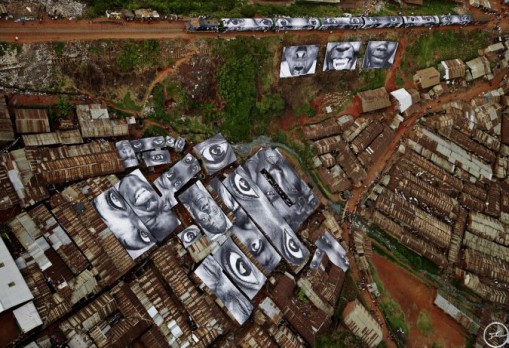
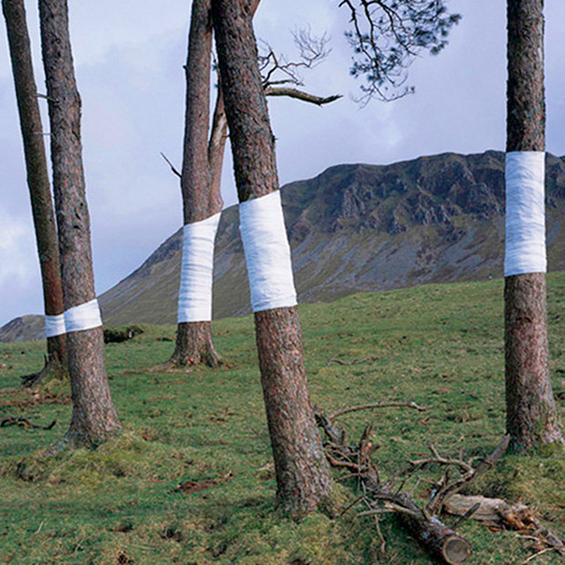
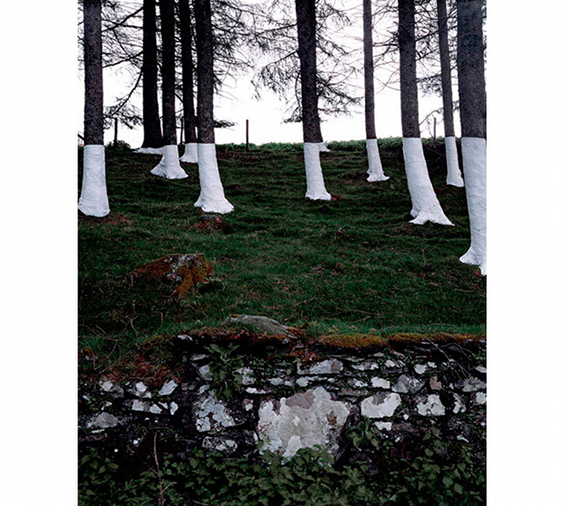
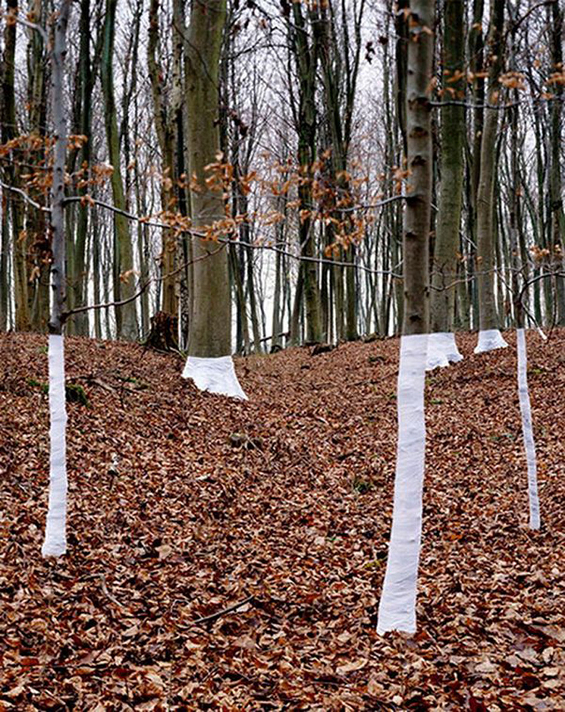
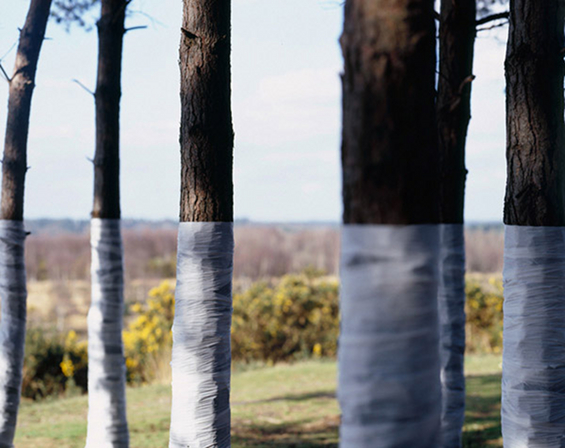
TREE, LINE / ZANDER OLSEN
‘This is an ongoing series of constructed photographs rooted in the forest. These works, carried out in Surrey, Hampshire and Wales,involve site specific interventions in the landscape, ‘wrapping’ trees with white material to construct a visual relationship between tree, not-tree and the line of horizon according to the camera’s viewpoint.’
MASTER OF ARCHITECTURAL ILLUSION / FELICE VARINI
Felice Varini has been using anamorphosis since 1979, an illusion created by flat graphic interventions on three-dimensional spaces. Online these images may seem nothing more than a photoshop manipulation but seeing one of Varini’s interventions at the 2008 Singapore Biennale, they are as enchanting physically as they are optically.
When viewed from a certain position or vantage point the painted elements come together, so that the seeming broken shapes like blips and blots come into perfect harmony as drawn line.
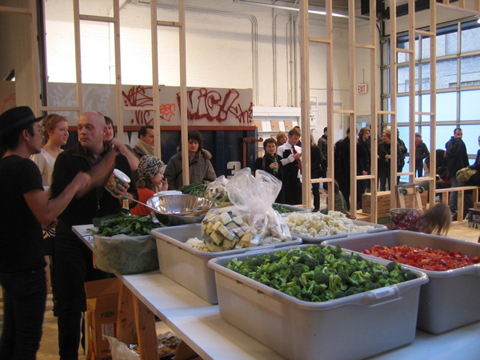
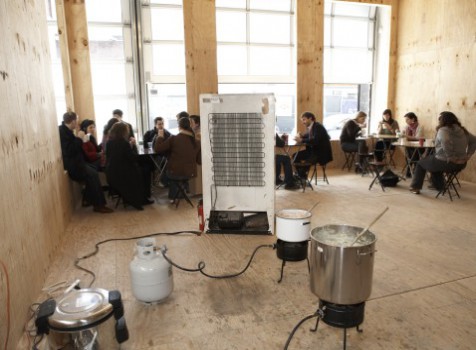
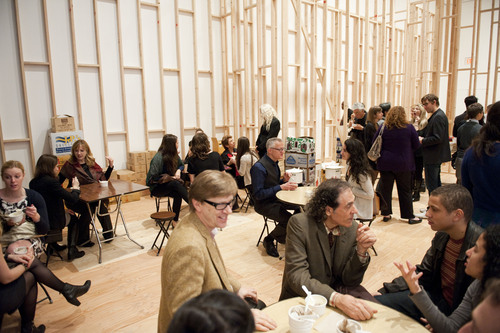
UNTITLED (FREE) / RIRKRIT TIRAVANIJA
In 1992, Rirkrit Tiravanija created an exhibition entitled Untitled (Free) at 303 Gallery in New York. This landmark piece, in which the artist converted a gallery into a kitchen where he served rice and Thai curry for free, has been recreated at MoMA as part of the installation Contemporary Galleries: 1980–Now on view on the second floor. This back office curry kitchen has been replicated to scale, and the artist worked with MoMA to recreate the experience, with curry prepared and served by the Museum’s restaurant staff daily from noon—3:00 p.m.
In this deceptively simple conceptual piece, the artist invites the visitor to interact with contemporary art in a more sociable way, and blurs the distance between artist and viewer. You aren’t looking at the art, but are part of it—and are, in fact, making the art as you eat curry and talk with friends or new acquaintances.
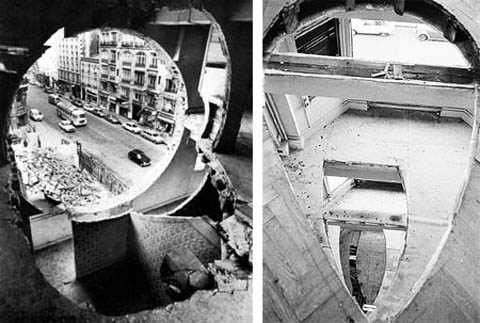
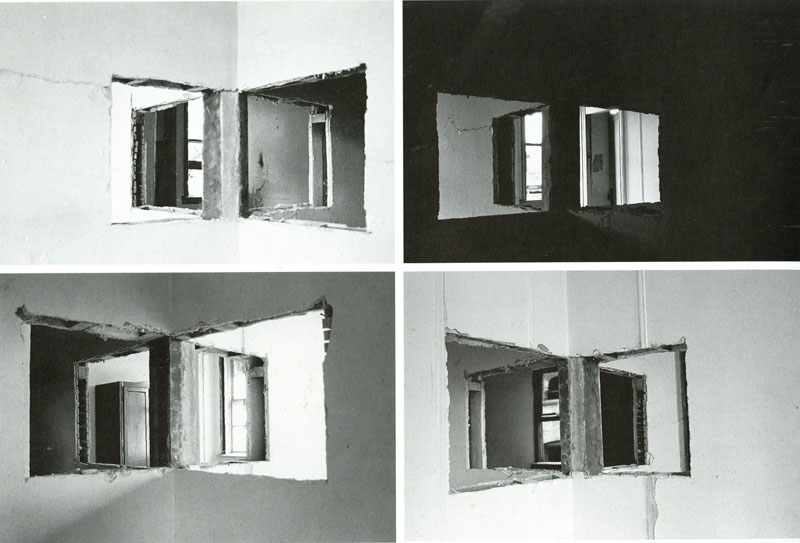
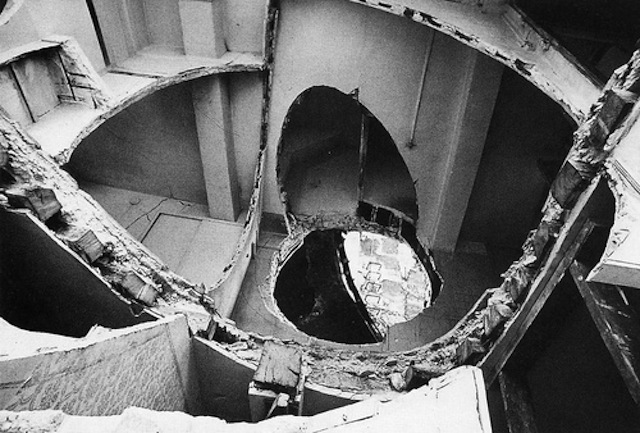
SPLITTING / GORDON MATTA-CLARK
During the 1970s, Matta-Clark made the works for which he is best known: his "anarchitecture." These were temporary works created by sawing and carving sections out of buildings, most of which were scheduled to be destroyed. He documented these projects in photography and film. Although he made interventions into a former iron foundry in Genoa, Italy, in 1973, his first large-scale project has been defined as Splitting (1974). To create this work, Matta-Clark sawed two parallel slices through a nondescript wood-frame house in Englewood, New Jersey, and removed the material between the two cuts. In addition, he cut out the corners of the house's roof, which were subsequently shown at John Gibson Gallery in New York. He made similar gestures in some of his photographs, cutting the actual negatives rather than manipulating individual prints.
TURNING THE PLACE OVER / RICHARD WILSON
The work consisted of a vast 10 metre diameter ovoid section of the facade of a disused building in Liverpool. This section of facade had been cut free allowing it to rotate.
This was made possible by mounting the ovoid section of architecture onto a central spindle, aligned at a specific angle to the building. When at rest the ovoid section of façade fitted flush into the rest of the building. The angled spindle was, however, placed on a set of powerful motorised industrial rollers, allowing it to rotate 360 degrees continuously. As it rotated, the facade not only became completely inverted but also oscillated into the building and out into the street, revealing the interior of the building, and only being flush with the building at one point during its rotation. This created an acute sense of disorientation and even danger for the viewer as the architecture physically encroaches on them.
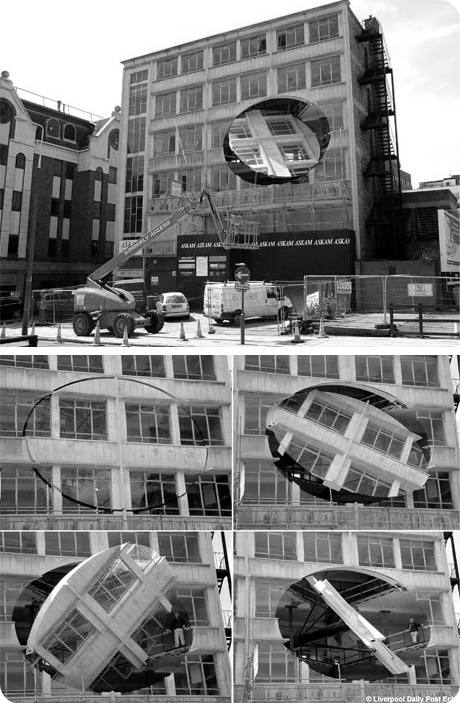
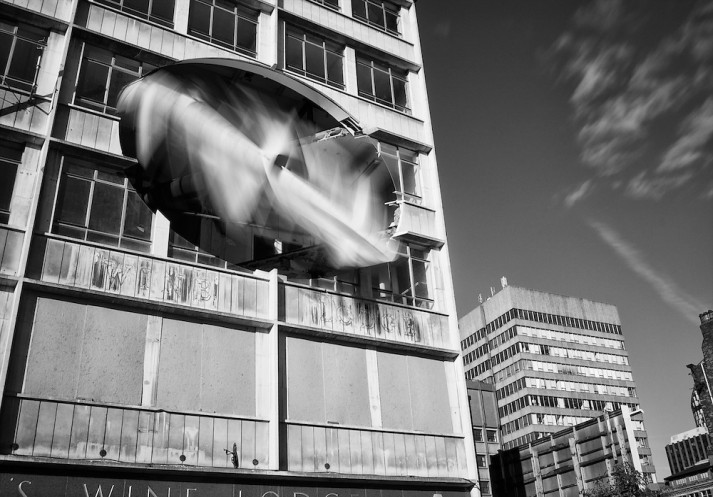
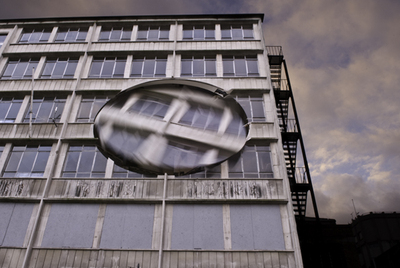
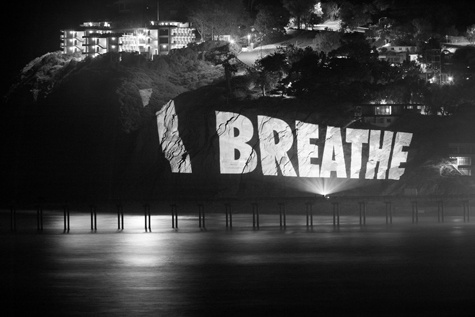
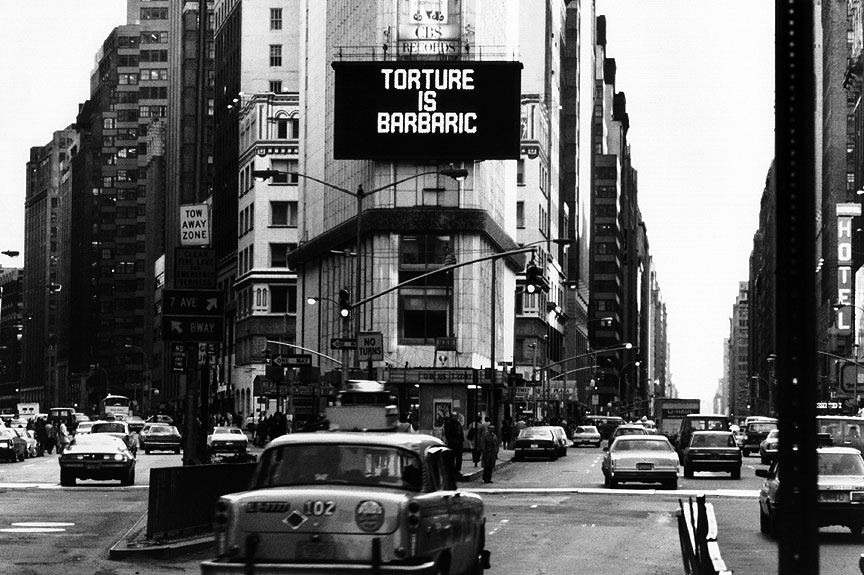
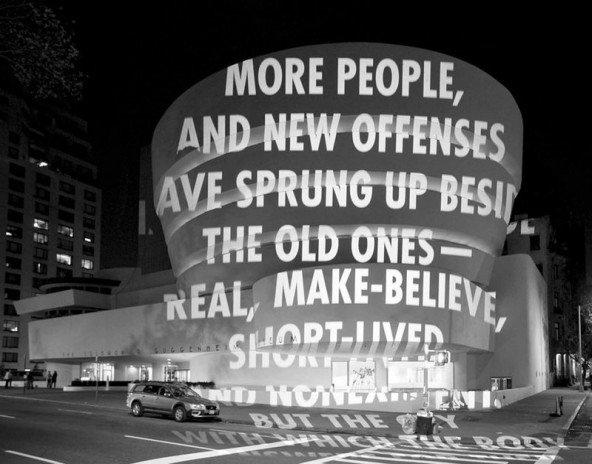
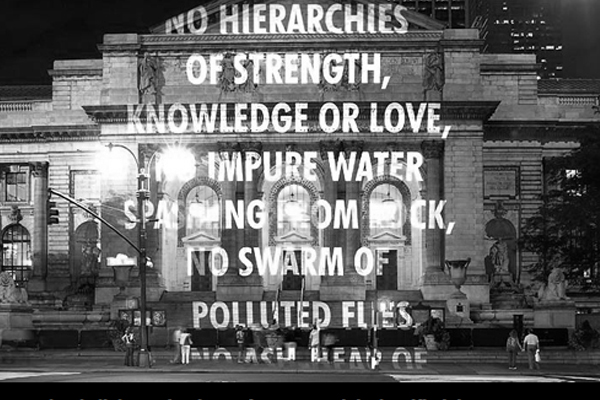
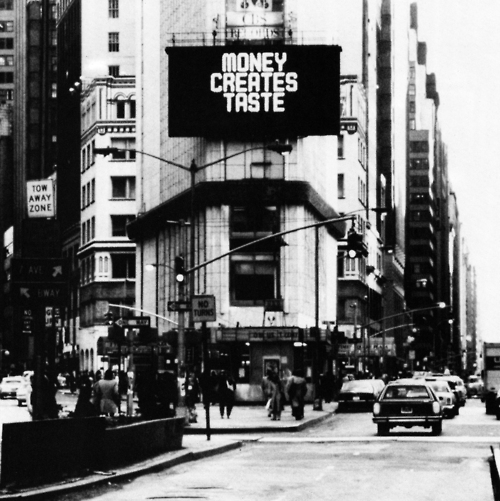
FOR (THE)(NEW YORK) CITY / JENNY HOLZER
FOR NEW YORK CITY marked Holzer's return to New York, the city where she first rose to prominence in the early 1980s. Her last significant pubic art intervention in New York took place over a decade ago, when she adorned marquees with selections from her Truisms and Survival series as part of Creative Time's 42nd Street Art Project in 1993-94.
FOR THE CITY continues a series of projections Holzer presented with Creative Time last fall. Planned to coincide with the 2004 Presidential election, FOR NEW YORK CITY illuminated The Cathedral Church of Saint John the Divine, Bethesda Fountain in Central Park, 515 Greenwich Street, Hotel Pennsylvania, and The Cooper Union with the powerful words of Wislawa Szymborska, Yehuda Amichai, Henri Cole, and others. Poetry was offered up to the public in a clean and temporary distillation of light, affirming the wisdom of the unobtrusive.
Holzer's projections have taken place in three continents, and over ten countries, including Austria, Brazil, France, Germany, Italy, Spain, and the United States, and nearly twenty cities including Florence, Rome, Rio de Janeiro, Venice, Berlin, and Paris. From Mies van der Rohe's Neue Nationalgalerie and Daniel Libeskind's Jüdisches Museum in Berlin to I.M. Pei's Pyramide du Louvre, Holzer's light projections have illuminated significant architectural spaces.
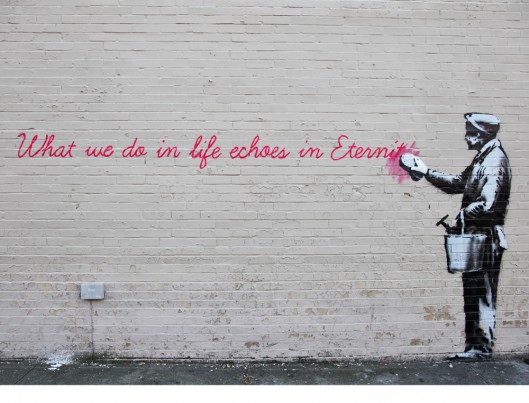
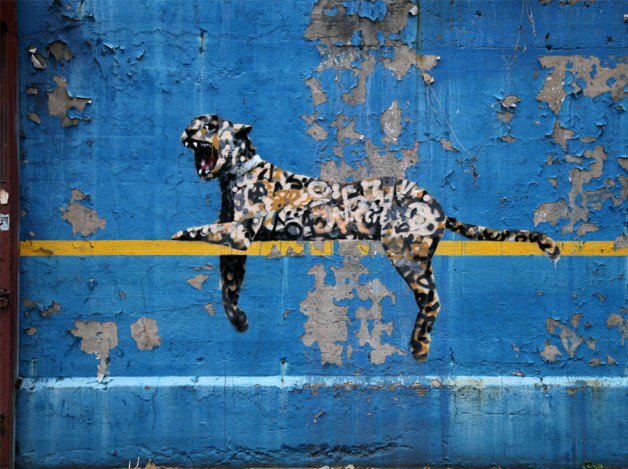
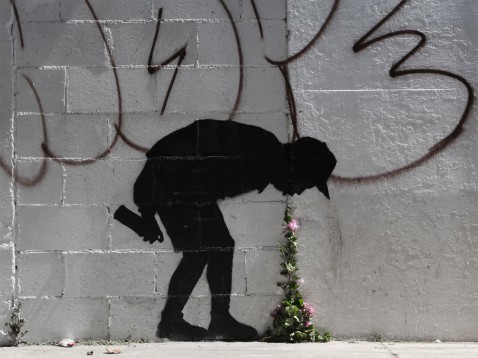
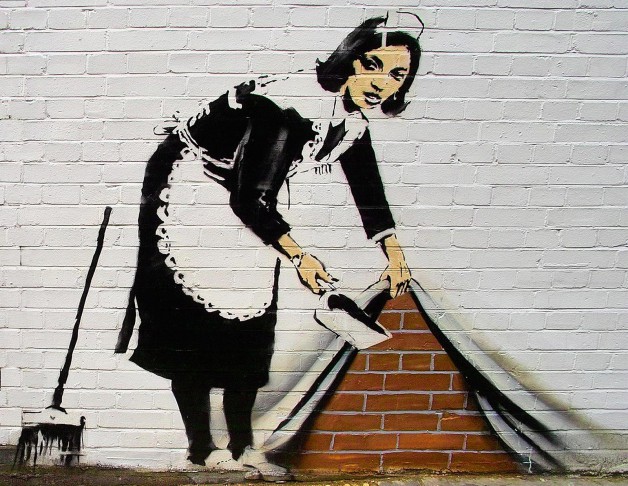
BANKSY'S STREET ART
Most of his fans don’t really want to know who he is (and have loudly protested Fleet Street attempts to unmask him). But they do want to follow his upward trajectory from the outlaw spraying—or, as the argot has it, “bombing”—walls in Bristol, England, during the 1990s to the artist whose work commands hundreds of thousands of dollars in the auction houses of Britain and America. Today, he has bombed cities from Vienna to San Francisco, Barcelona to Paris and Detroit. And he has moved from graffiti on gritty urban walls to paint on canvas, conceptual sculpture and even film, with the guileful documentary Exit Through the Gift Shop, which was nominated for an Academy Award.
Pest Control, the tongue-in-cheek-titled organization set up by the artist to authenticate the real Banksy artwork, also protects him from prying outsiders. Hiding behind a paper bag, or, more commonly, e-mail, Banksy relentlessly controls his own narrative. His last face-to-face interview took place in 2003.
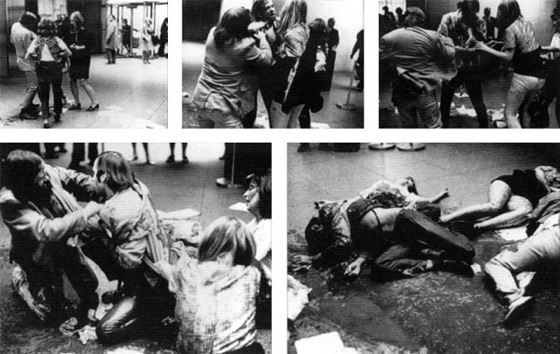
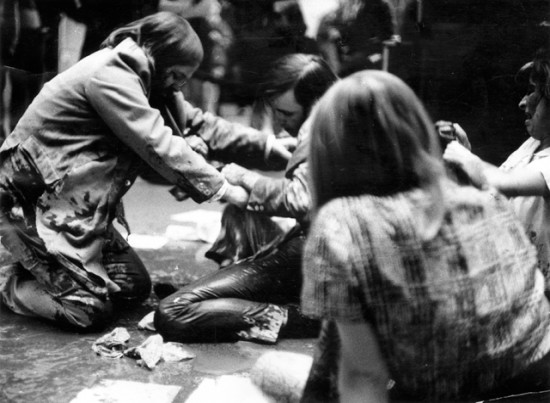
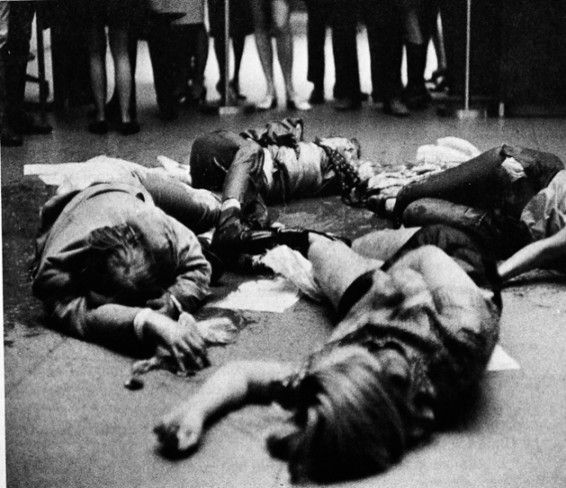
"BLOODBATH" / GUERILLA ART ACTION GROUP
With support from the Action Committee of the Art Workers’ Coalition, Guerrilla Art Action Group (GAAG) performed Blood Bath in the Museum of Modern Art’s lobby on November 18, 1969. Jon Hendricks, Poppy Johnson, Jean Toche, and Silvianna Goldsmith entered the museum at 3:10 p.m. on a Tuesday wearing street clothes for the women and suits and ties for the men.
Inside their clothing, they hid two gallons of beef blood distributed in plastic bags taped to their bodies. The artists walked to the center of the lobby and threw one hundred copies of their demands to the floor. This statement insisted that the Rockefeller brothers, who owned considerable percentages of multiple companies that were profiting from Vietnam war-related labor and weapons manufacturing, resign from the Board of Directors at MoMA.
PLACE AU CHANGEGEMENT PUBLIC PLAZA / COLLECTIF ETC
After winning a competition commissioned by the Public Urban Planning Agency of Saint-Étienne (France), the Collectif Etc designed a public square of 670 sqm and built it with the inhabitants in a participative process in July 2011.
At the intersection of two streets, the site was formerly a wasteland. Answering the on-going urban changes in the neighborhood, the project simulates a first step of the process in which a building is designed and built. The idea is to represent the plan of imaginary housings on the ground and their section on the wall. Now people can imagine living in the future buildings and get an idea of the impact of the real one that should be built in a couple of years.
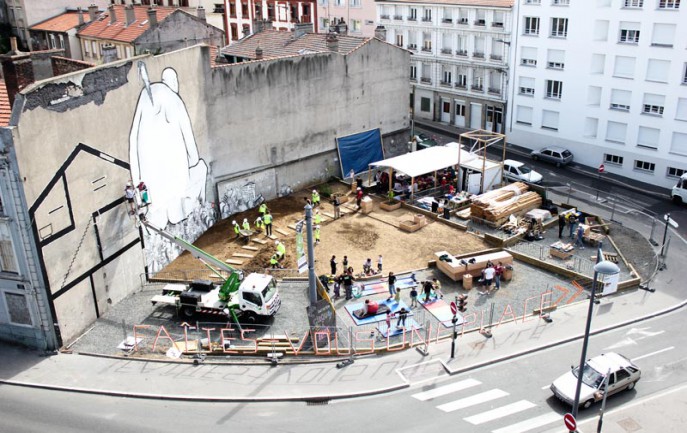
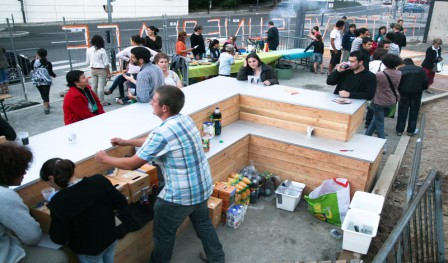
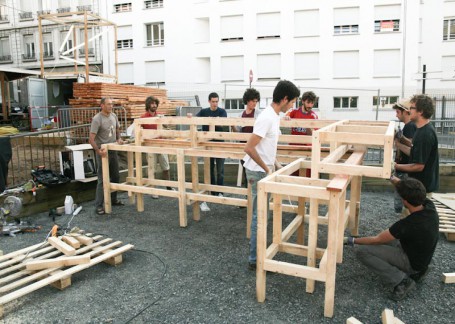
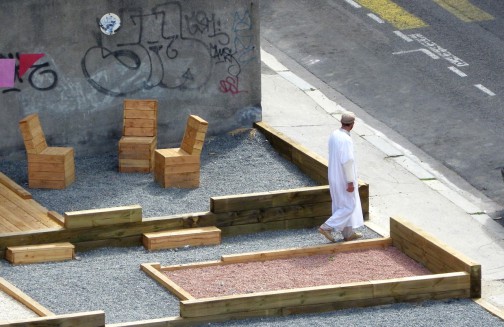
FAVELA PAINTING / HANS&HAHN
Haas & Hahn is de werktitel van het kunstenaarsduo Jeroen Koolhaas en Dre Urhahn. Jeroen Koolhaas is afgestudeerd op de Design Academy in Eindhoven met de disipline Grafisch Ontwerpen. Hij is sinds zijn afstuderen freelance audio-visueel ontwerper en illustrator voor de New Yorker. Dre Urhahn heeft gewerkt als journalist, copywriter en art-director en heeft verschillende bedrijven opgezet in de evenementensector en de televisie productie. Ze zijn in 2005 begonnen met een samenwerkingsverband, toen ze een documentaire over Hip-Hop gingen maken voor MTV in de favelas in Rio de Janeiro en São Paolo. Dit bezoek heeft hun geïnspireerd en ze zijn teruggegaan naar Brazilië om samen met de jeugd daar grote kunstwerken te maken op de muren van sloppenwijken.
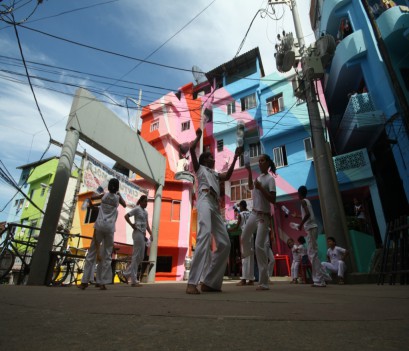
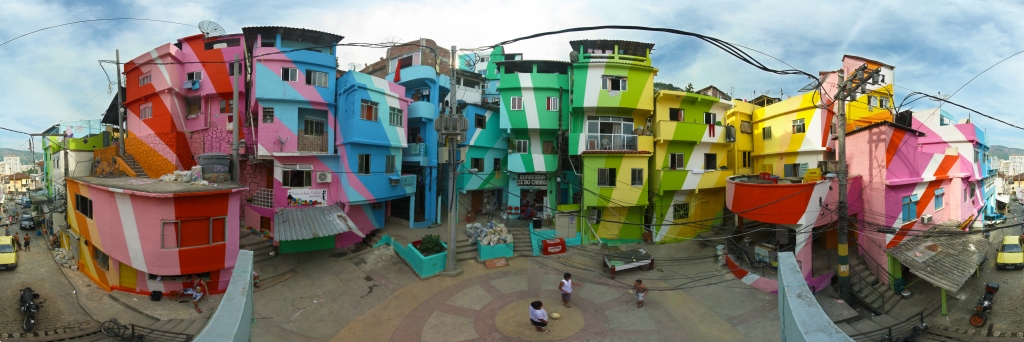
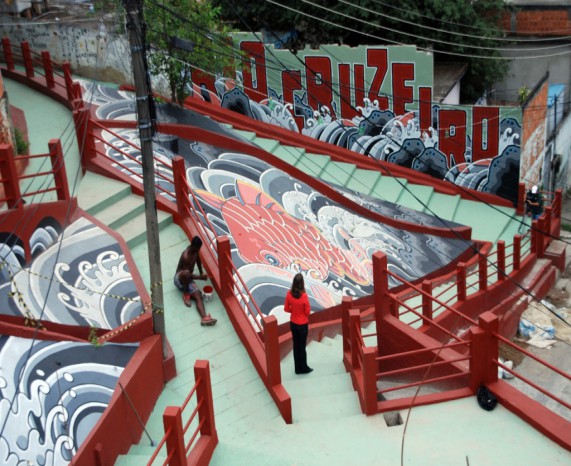
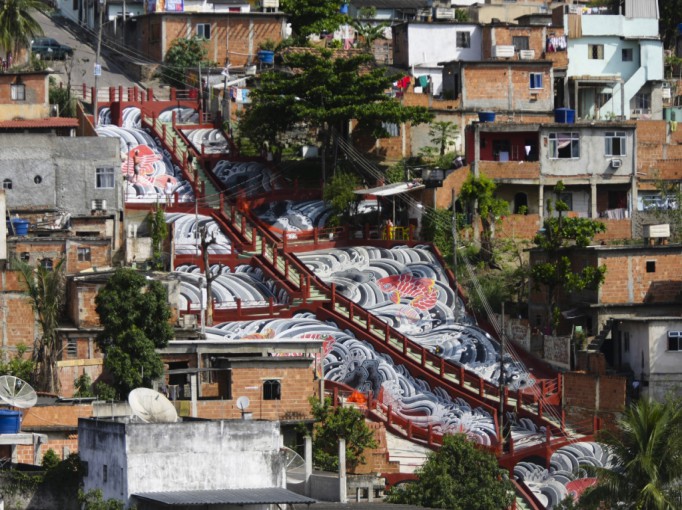
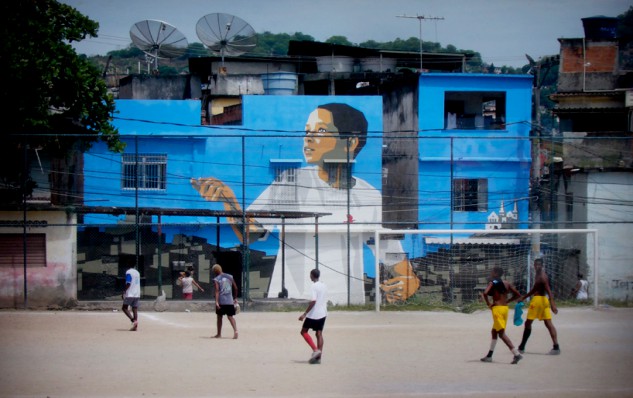
BEFORE I DIEI WANT TO... / CANDY CHANG
Taiwanese-American artist Candy Chang challenges the conventional perception of public space and the role it can play in the well-being of the community and the individual. She is renowned for interactive public installations that provoke civic engagement and emotional introspection and she believes public art can play a profound role in helping us make sense of the beauty and tragedy of life with the people around us.
After Candy Chang lost someone she loved, she went through a long period of grief and depression. With time she felt gratitude for the time they had together and eventually she found clarity in her life by contemplating death so much, but she struggled to maintain this perspective. It’s easy to get caught up in the day-to-day and forget what really matters to you. She wanted a daily reminder and she wanted to know what was important to the people around her. So after receiving permission, she painted the side of an abandoned house in her neighborhood in New Orleans with chalkboard paint and stenciled it with a grid of the sentence, “Before I die I want to _______.” Anyone walking by could pick up a piece of chalk, reflect on their lives, and share their personal aspirations in public space.
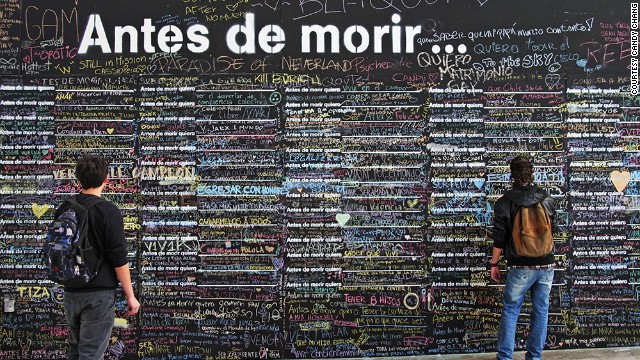

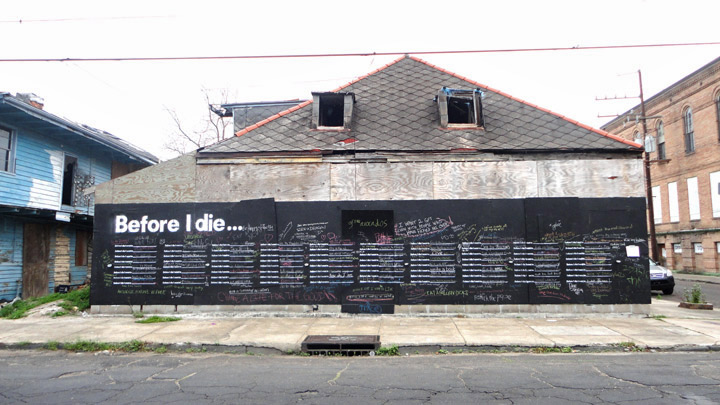
THE REAL ESTATE / AL/ARCH
The ‘vertical public park’ designed by Al/Arch for the dense urban area of Bat-Yam Israel transformed one of those strange edge areas left by thoughtless city planners; in this case an awkward void between the end of a residential street and the freeway.
The surfacing is actually a concrete ‘blanket’, which slopes upwards to a wall with niches whose forms reflect human interactions (single, couple, group), though the kids climbing there don’t care much for the symbology, just for the uniquely textured space! The choice of material cleverly reflects the site’s previous history as a space for dumping trash, including mattresses.
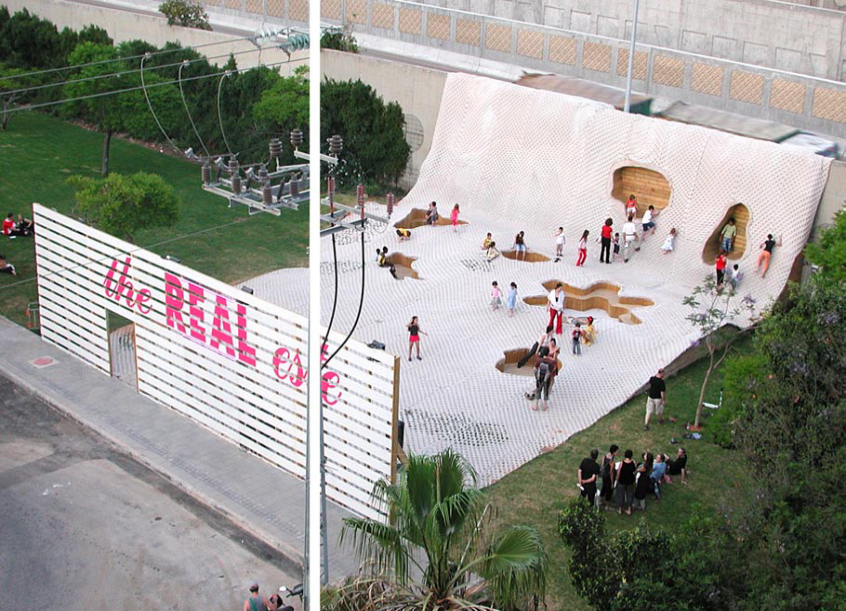
CHEWING IN VENICE / SIMONE DECKER
Simone Decker is well known in Luxembourg for several personal exhibitions at the Casino Luxembourg – Forum d’art contemporain, and for her participation in 1999 in the 48th Venice Biennale, as part of the Luxembourg pavilion. Her works most often take the architectural context as a point of departure, as well as the institutional context in which she is invited to intervene. These works are, as the artist emphasises, “realised in the place, but above all, with the place”. By means of interventions that are sometimes discreet, sometimes more explicit, they invite the spectator to renew his or her perception of the spaces. An aspect of her approach consists of staging interventions on particular spaces by means of photography. This is the case, for example, in her series of sculptures in chewing-gum realised in the streets of Venice, using a system of trompe l’œil as simple as it is cunning (Chewing in Venice).
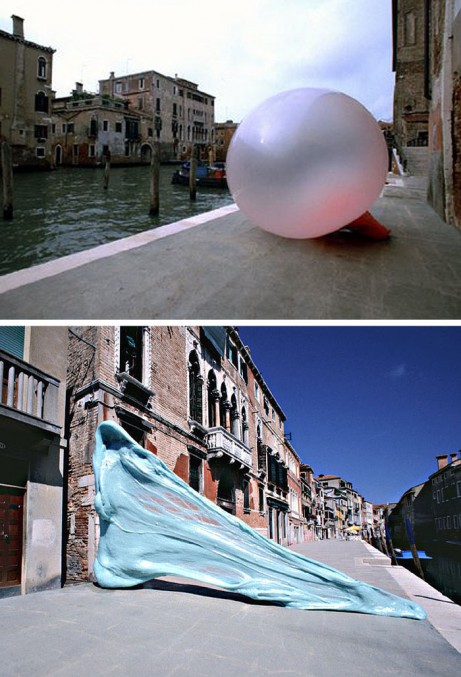
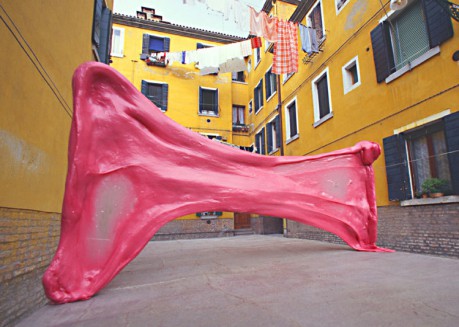
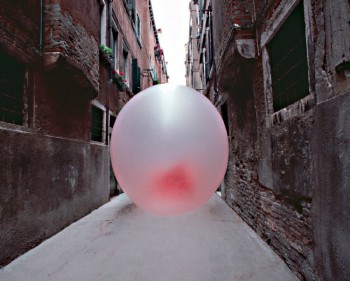
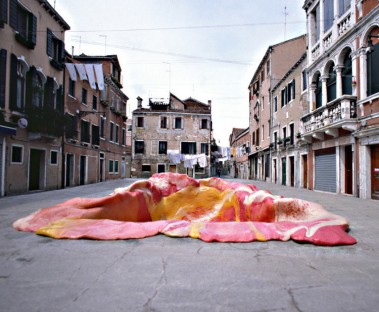
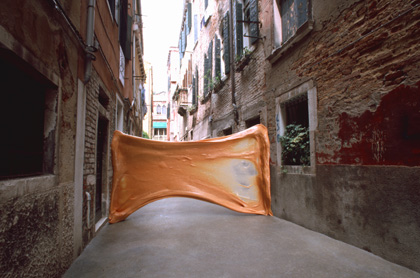
COLOR JAM / JESSICA STOCKHOLDER
Colorful urban interventions are probably the best kind: they’re bright, they’re fun, and they’re wonderfully unconventional. We’ve written about painted bus loops in Bratislava and painted roadways in small Swiss villages before, but this one just takes the cake.
American visual artist Jessica Stockholder brings us Color Jam, an art piece that will span hundreds of meters and be located on sidewalks, roadways, and the sides of buildings this Summer in Chicago. Located at a major intersection in Chicago’s Loop, fluorescent colors will cover every part of, well, every thing, placing the passerby dead in the centre of the piece.
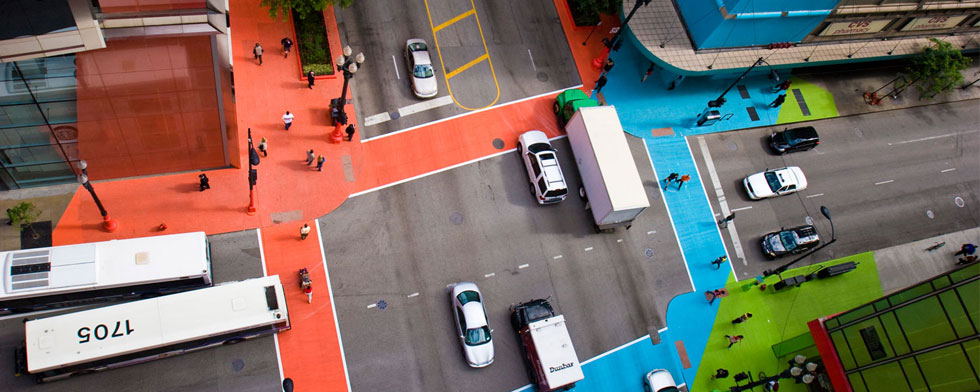
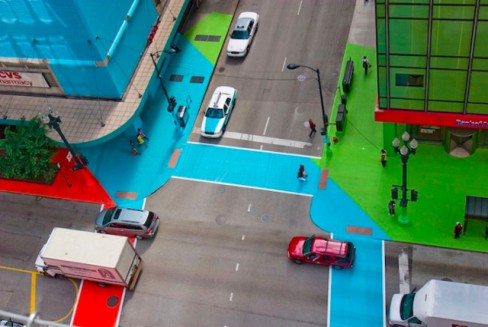
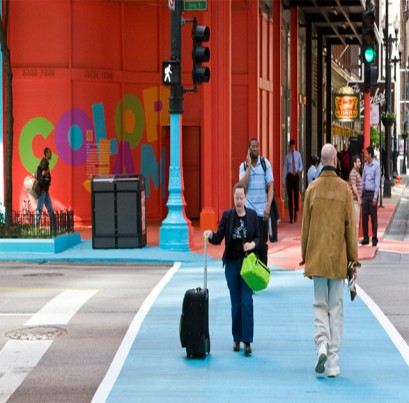
THE LONGEST BENCH / STUDIO WEAVE
The longest bench in Britain was opened to the public in Littlehampton, West Sussex on the 30th July 2010.The bench seats over 300 people along Littlehampton’s promenade, overlooking the town’s award-winning Blue Flag beach. Designed by Studio Weave, the structure sinuously travels along the promenade, meandering around lampposts, bending behind bins, and ducking down into the ground to allow access between the beach and the Green. Like a seaside boardwalk the Longest Bench rests gently on its habitat and adapts to its surroundings while like a charm bracelet it connects and defines the promenade as a whole, underlining it as a collection of special places that can be added to throughout its lifetime.The bench is made from thousands of tropical hardwood slats engraved with messages from its supporters. The timber is 100% reclaimed from sources including old seaside groynes and rescued from landfill. The beautiful variety of reclaimed timbers are interspersed with splashes of bright colour wherever the bench wiggles, bends or dips.Accompanying the long bench are two bronze-finished steel monocoque loops that connect the promenade with the green behind it. As the bench arrives inside the twisting loops it goes a little bit haywire, bouncing of the walls and ceiling creating seats and openings. The loop contains the haywire stretch of bench and frames the views each way.
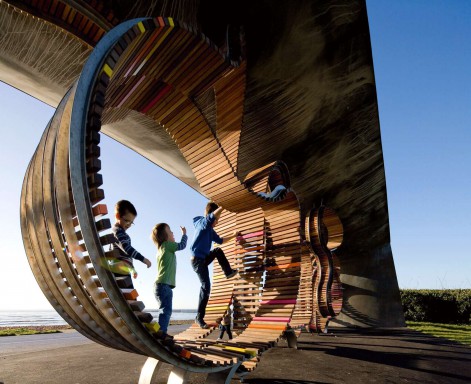

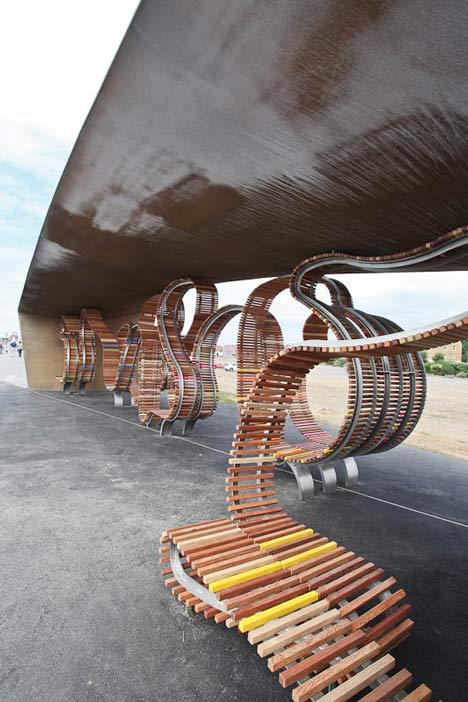
kunst
Voorbeelden van (publieke) interventies in de (autonome en beeldende) kunst en architectuur